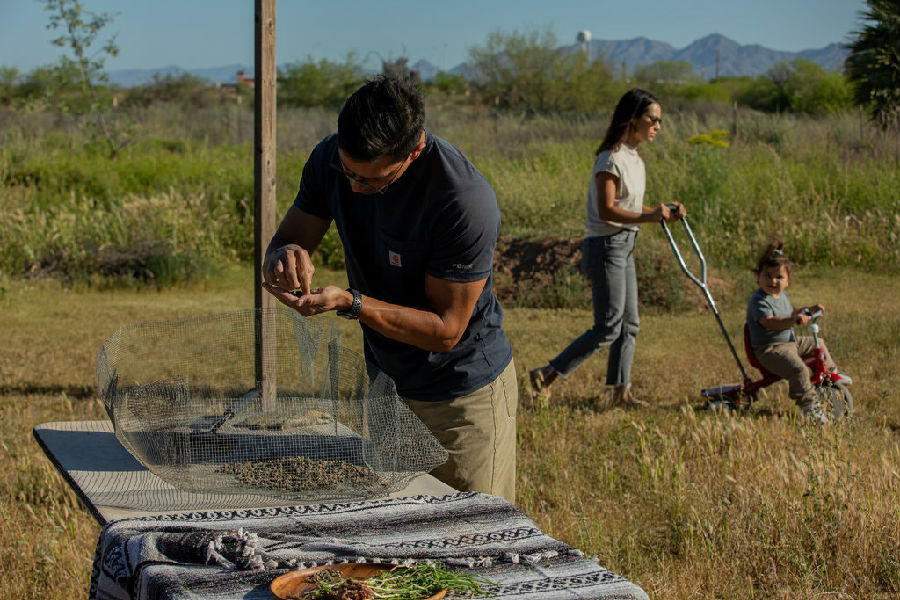Food shortages, though, are just one in a thicket of troubles on tribal lands.
然而,土著部落的生计面临重重困难,粮食短缺只是其中之一。
Many have become Superfund sites where oil spills or chemical runoffs have contaminated the groundwater.
许多部落所在地都是“超级基金”覆盖点,他们的地下水早就被石油泄漏或化学品径流污染了。
More than a century of government policies have shrunk Native American territory and taken ownership from tribal governments,
一个多世纪以来,政府政策不断收缩原住民的领土,抢夺部落政府手中的所有权,
contributing to the rampant poverty and poor health care on many reservations.
导致许多保留地本就十分严重的贫困问题和医疗匮乏问题更加雪上加霜。
The coronavirus emergency is dire on the Navajo Nation in Arizona, Utah and New Mexico, which as of Monday had 698 cases and 24 deaths.
亚利桑那州、犹他州和新墨西哥州的纳瓦霍部落出现了新冠疫情大爆发,截至周一,该部落已有698例病例,24人已经不治身亡。
Many residents lack running water and electricity, and all were under a 57-hour curfew that ended Monday morning.
许多居民过的都还是没有自来水也没有电的生活,且所有人都经历了长达57小时的宵禁,一直到周一上午才结束。
“People are told to self-isolate at home with no drinking water and not enough food,”
“大家被告知要在家隔离,问题是家里既没有饮用水,也没有足够的食物,”
said Denisa Livingston, a councilor for Slow Food International who helps her fellow Native Americans grow their own food.
正在帮助其他原住民同胞自己种植食物的国际慢食组织议员德尼萨·利文斯顿说。
The nation, has mobilized what resources it has.
该部落正在调动其手上的所有资源。
Residents with gardens are making their crops available to others.
有自家菜园的原住民开始拿出自己的瓜果蔬菜与他人共享。
Some are assembling care packages for elders that include, among other things, ingredients for fry bread,
一些人开始为部落里的老人打包爱心食材包,其中包括但不限于炸面包的配料,
a Navajo staple with a complicated history, as it was created using rations from the federal government.
炸面包是纳瓦霍人的一种主食,由于这种食物是用联邦政府发放的配给制作的,其历史颇为纠葛。
The Turtle Mountain Band of Chippewa has a strong tradition of canning local crops like beets, cucumbers and carrots, and some families are known for their expertise.
奇佩瓦龟山部落地区的人们一直有着用甜菜、黄瓜和胡萝卜等当地作物制作罐头的传统,甚至有一些家庭因擅长制作这类罐头有了不小的名气。
Many are now donating their stockpiles to those on the reservation in need.
如今,很多人都慷慨地拿出了他们的库存,捐给了保留地上有需要的同胞。
“You don’t think twice about it,” said Mr. Azure, the tribal chairman.
“(以前)这些传统你根本都不会细想,”部落首领阿祖尔说。
“And then when the Covid-19 threat comes through, you realize how important all of this is.”
“然后,新冠肺炎来了,你突然会意识到,这些传统原来是那么的重要。”

In Alaska, the Athabaskan peoples have long dealt with brutal, protracted winters by preserving produce and freezing meats.
通过保存农产品,冷冻肉类来应付严酷而漫长的冬天,这样的做法对阿拉斯加的阿萨巴斯卡人来说早已不新鲜。
Cynthia Erickson, who is Athabaskan and an owner of the only grocery store in her village, Tanana, has a freezer full of moose, caribou and whitefish.
辛西娅·埃里克森就是阿萨巴斯卡人,她开的杂货店——也是村子里的唯一一家杂货店——的冰箱里囤满了驼鹿肉、驯鹿肉和白鱼肉。
She has been struggling to get her usual wholesale suppliers to fill orders.
最近,一直合作的批发商已经无法再为她提供所有订单的配货。
The tribe may ask Gov. Mike Dunleavy to open moose hunting season (which normally begins in August or September) early if the food supply runs low, she said.
她说,如果食物供应出现短缺,部落可能会要求州长迈克·邓利维提前开放(通常于8月或9月开始的)驼鹿狩猎季。
“My grandparents had 12 kids and a little cabin, and they survived hunting beavers, moose and fish,” said Ms. Erickson, 56.
“我爷爷奶奶生了12个孩子,还只有一间小木屋,他们就捕海狸、捕驼鹿,捕鱼,结果还不是活了下来。”56岁的埃里克森说:
They boiled hooves and legs to make broth.
他们把蹄子和腿煮成肉汤。
“We are tough people.”
“我们没那么娇气。”
White corn production is ramping up on the Oneida Nation of Wisconsin’s reservation, in the eastern part of the state.
威斯康星州东部威斯康星保留地奥奈达部落的白玉米产量正在增加。
The crop is sacred to the Oneida Nation, and a longstanding staple because of its many nutrients.
该作物对奥奈达部落而言十分神圣,因其营养丰富,该作物也一直是该部落的主食。
Rebecca and Stephen Webster, a Native married couple who own a 10-acre farm that grows white corn and other produce,
丽贝卡·韦伯斯特和斯蒂芬·韦伯斯特是当地的一对夫妻,他们有一个10英亩的农场,里面种的就是白玉米还有其他农产品,
have been giving their prized seeds to families on the reservation in exchange for whatever they can offer, even if it’s just a jar of jam.
现在,他们拿出了自己家珍贵的种子,与保留地上的其他家庭交换,凡是后者能拿出来的,哪怕只是一罐果酱,他们都愿意换。
On the San Carlos Apache Indian Reservation, in southeastern Arizona,
在亚利桑那州东南部的圣卡洛斯·阿帕奇印第安人保留地,
many homes are low-income units where residents say they have been told in the past that gardens weren’t allowed.
许多家庭都是低收入家庭,居民们说,过去,他们曾被告知不准自行种植作物。
译文由可可原创,仅供学习交流使用,未经许可请勿转载。













